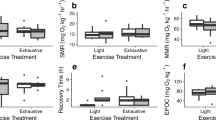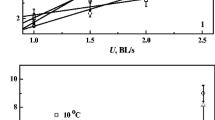Abstract
To investigate the effects of exhaustive chasing training and detraining on the swimming performance of juvenile darkbarbel catfish (Peltebagrus vachelli Richardson), we performed exhaustive chasing training daily for 14 days and subsequently detrained fish for 7 days. Chasing training resulted in significant increases in critical swimming speed (U crit), post-chasing peak oxygen consumption rate (VO2 peak), and heart and gill indexes compared with non-trained controls. Both resting oxygen consumption (VO2 rest) and excess post-chasing VO2 (EPOC) were unaffected by exhaustive chasing training. Fish that underwent chasing training had lower levels of whole-body lipid content and reduced food intake and growth compared with non-trained control fish; however, condition factor was not affected by chasing training. Seven days of detraining reversed the effects of exhaustive chasing training. Overall, these data suggested that short-term exhaustive chasing training improves aerobic swimming capacity in darkbarbel catfish, but the training effects are reversible over a short period of time.





Similar content being viewed by others
References
Andersen LL, Andersen JL, Magnusson SP, Aagaard P (2005) Neuromuscular adaptations to detraining following resistance training in previously untrained subjects. Eur J Appl Physiol 93:511–518
Association of Official Analytical Chemists (AOAC) (1995) Official methods of analysis, 16th ed edn. AOAC, Arlington
Bagatto B, Pelster B, Burggren WW (2001) Growth and metabolism of larval zebrafish: effects of swim training. J Exp Biol 204:4335–4343
Botcazou M, Zouhal H, Jacob C, Gratas-Delamarche A, Berthon PM, Bentue-Ferrer D, Delamarche P (2006) Effect of training and detraining on catecholamine responses to sprint exercise in adolescent girls. Eur J Appl Physiol 97:68–75
Brett JR (1964) The respiratory metabolism and swimming performance of young sockeye salmon. J Fish Res Board Can 21:1183–1226
Burgetz IJ, Rojas-Vargas A, Hinch SG, Randall DJ (1998) Initial recruitment of anaerobic metabolism during sub-maximal swimming in rainbow trout (Oncorhynchus mykiss). J Exp Biol 201:2711–2721
Craig JE (1977) The body composition of the adult perch, Perca fluviatilis in Windermere, with reference to seasonal changes and reproduction. J Anim Ecol 46:617–632
Davison W (1997) The effects of exercise training on teleost fish, a review of recent literature. Comp Biochem Physiol A 117:67–75
Dawson AS, Grimm AS (1980) Quantitative changes in the protein, lipid and energy content of the carcass, ovaries and liver of adult female plaice, Plerounecs platessa L. J Fish Biol 16:493–504
Ding RH (1994) The fishes of Sichuan. Sichuan Publishing House of Science and Technology, Chengdou
Duan XB, Chen DQ, Liu SP, Chi CG, Yang RH (2002) Studies on status of fishery resources in Three Gorges reservoir reaches of the Yangtze River. Acta Hydrobiol Sin 26:605–611
Farrell AP, Johansen JA, Steffensen JF, Moyes CD, West TG, Suarezr K (1990) Effects of exercise training and coronary ablation on swimming performance, heart size, and cardiac enzymes in rainbow trout, Oncorhynchus mykiss. Can J Zool 68:1174–1179
Farrell AP, Johansen JA, Suarez RK (1991) Effects of exercise-training on cardiac performance and muscle enzymes in rainbow trout, Oncorhynchus mykiss. Fish Physiol Biochem 9:303–312
Fu SJ, Cao ZD, Peng JL (2007) Resting metabolic rate and body mass change of Silurus meridionalis to exhaustive exercise training and fasting. Chin J Zool 42(6):103–107
Fu SJ, Cao ZD, Peng JL, Wang YX (2009) Effect of meal size on excess post-exercise oxygen consumption in fishes with different locomotive and digestive performance. J Comp Pysiol B 179:509–517
Gallaugher PE, Thorarensen H, Kiessling A, Farrell AP (2001) Effects of high intensity exercise training on cardiovascular function, oxygen uptake, internal oxygen transport and osmotic balance in chinook salmon (Oncorhynchus tshawytscha) during critical speed swimming. J Exp Biol 204:2861–2872
Gamperl AK, Bryant J, Stevens ED (1988) Effect of a sprint training protocol on growth rate, conversion efficiency, food consumption and body composition of rainbow trout, Salmo gairdneri Richardson. J Fish Biol 33:861–870
Garland T, Paul JR, Else L, Hulbert AJ, Tap P (1987) Effects of endurance training and captivity on activity metabolism of lizards. Am J Physiol R 252:450–456
Guy PS, Snow DH (1977) The effect of training and detraining on muscle composition in the horse. J Physiol 269:33–51
Haggmark T, Jansson E, Eriksson E (1981) Fiber type area and metabolic potential of the thigh muscle in man after knee surgery and immobilization. Int J Sports Med 2:12–17
Häkkinen K, Alen M, Kallinen M, Newton RU, Kraemer WJ (2000) Neuromuscular adaption during prolonged strength training, detraining and re-strength-training in middle-aged and elderly people. Eur J Appl Physiol 83:51–62
Hansen AL, Johnsen BH, Sollers JJ, Stenvik K, Thayer JF (2004) Heart rate variability and its relation to prefrontal cognitive function: the effects of training and detraining. Eur J Appl Physiol 93:263–272
Hinterleitner S, Huber M, Hackner R, Wieser W (1992) Systemic and enzymatic responses to endurance training in two cyprinid species with different life styles (Teleostei: Cyprinidae). Can J Fish Aquat Sci 49:110–115
Holk K, Lykkeboe G (1998) The impact of endurance training on arterial plasma K+ levels and swimming performance of rainbow trout. J Exp Biol 201:1373–1380
Hudlicka O (1985) Development and adaptability of microvasculature in skeletal muscle. J Exp Biol 115:215–228
Johnston IA, Moon TW (1980) Endurance exercise training in the fast and slow muscles of a teleost fish (Pollachius virens). J Comp Physiol B 135:147–156
Kieffer JD (2000) Limits to exhaustive exercise in fish. Comp Biochem Physiol A 126:161–179
Lackner R, Wieser W, Huber M, Dallavia J (1988) Responses of intermediary metabolism to acute handling stress and recovery in untrained and trained Leuciscus cephalus (Cyprinidae, teleost). J Exp Biol 140:393–404
Lauff RF, Wood CM (1997) Effects of training on respiratory gas exchange, nitrogenous waste excretion, and fuel usage during aerobic swimming in juvenile rainbow trout (Oncorhynchus mykiss). Can J Fish Aquat Sci 54:566–571
Lee CG, Devlin RH, Farrell AP (2003) Swimming performance, oxygen consumption and excess post-exercise oxygen consumption in adult transgenic and ocean-ranched coho salmon. J Fish Biol 62:753–766
Marini M, Falcieri E, Margonato V, Treré D, Lapalombella R, Tullio S, Marchionni C, Burattini S, Samaja M, Esposito F, Veicsteinas A (2008) Partial persistence of exercise-induced myocardial angiogenesis following 4-week detraining in the rat. Histochem Cell Biol 129:479–487
Martin CI, Johnston IA (2005) The role of myostatin and the calcineurin-signalling pathway in regulating muscle mass in response to exercise training in the rainbow trout Oncorhynchus mykiss Walbaum. J Exp Biol 208:2083–2090
McFarlane WJ, Heigenhauser GJF, McDonald DG (2001) Creatine supplementation affects sprint endurance in juvenile rainbow trout. Comp Biochem Physiol A 130:857–866
Nahhas R, Jones NV, Goldspink G (1982) Some aspects of sustained training of rainbow trout, Salmo gairdneri Richardson. J Fish Biol 20:351–358
Owerkowicz T, Baudinette RV (2008) Exercise training enhances aerobic capacity in juvenile estuarine crocodiles (Crocodylus porosus). Comp Biochem Physiol A 150:211–216
Pearson MP, Spriet LL, Stevens ED (1990) Effect of sprint training on swim performance and white muscle metabolism during exercise and recovery in rainbow trout (Salmo gairdneri). J Exp Biol 149:45–60
Pelster B, Sänger AM, Segle M, Schwerte T (2003) Influence of swim training on cardiac activity, tissue capillarization, and mitochondrial density in muscle tissue of zebrafish larvae. Am J Physiol R 285:339–347
Reidy SP, Kerr SR, Nelson JA (2000) Aerobic and anaerobic swimming performance of individual Atlantic cod. J Exp Biol 203:347–357
Scarabello M, Heigenhauser GJF, Wood CM (1992) Gas exchange, metabolite status and excess post-exercise oxygen consumption after repetitive bouts of exhaustive exercise in juvenile rainbow trout. J Exp Biol 167:155–169
Steffensen JF (1989) Some errors in respirometry of aquatic breathers: how to avoid and correct for them. Fish Physiol Biochem 6:49–59
Thorarensen H, Gallaugher PE, Kiessling AK, Farrell AP (1993) Intestinal blood flow in swimming chinook salmon oncorhynchus tshawytscha and the effects of haematocrit on blood flow distribution. J Exp Biol 179:115–129
Xie XJ, Sun RY (1990) The bioenergetics of the southern catfish (Silurus meridionalis Chen): resting metabolic rate as a function of body weight and temperature. Physiol Zool 63:1181–1195
Yogata H (2000) The effects of swimming exercise on growth and whole-body protein and fat contents of fed and unfed fingerling yellowtail. Fisher Sci 66:1100–1105
Young PS, Cech JJ (1993a) Improved growth, swimming performance, and muscular development in exercise-conditioned young-of-the-year striped bass (Morone saxatilis). Can J Fish Aquat Sci 50:703–787
Young PS, Cech JJ (1993b) Effects of exercise conditioning on stress responses and recovery in cultured and wild young-of-the-year striped bass, Morone saxatilis. Can J Fish Aquat Sci 58:2094–2899
Young PS, Cech JJ (1994) Optimum exercise conditioning velocity for growth, muscular development, and swimming performance in young-of-the-year striped bass (Morone saxatilis). Can J Fish Aquat Sci 51:519–1527
Zumwalt A (2006) The effect of endurance exercise on the morphology of muscle attachment sites. J Exp Biol 209:444–454
Acknowledgments
This study was supported by research grants from the National Science Foundation of China (NSFC 30700087) (granted to S.J.F.), Program for Excellent Talents in University of Chongqing City (granted to S.J.F.) and Research Project of Chongqing Education Committee (KJ080823) (granted to Z.D.C.). We thank Dr. Jeffery Richards for his constructive comments and suggestions to improve this manuscript. We declare that the experiments comply with the current laws of the country in which the experiments were performed.
Author information
Authors and Affiliations
Corresponding author
Additional information
Communicated by G. Heldmaier.
Rights and permissions
About this article
Cite this article
Liu, Y., Cao, ZD., Fu, SJ. et al. The effect of exhaustive chasing training and detraining on swimming performance in juvenile darkbarbel catfish (Peltebagrus vachelli). J Comp Physiol B 179, 847–855 (2009). https://doi.org/10.1007/s00360-009-0365-1
Received:
Revised:
Accepted:
Published:
Issue Date:
DOI: https://doi.org/10.1007/s00360-009-0365-1




